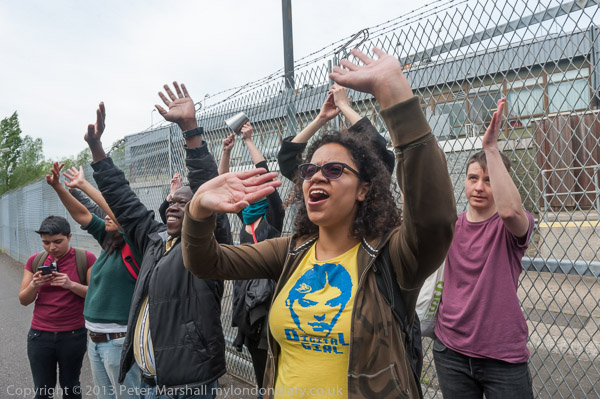
Technically Harmondsworth Immigration Detention Centre isn’t a prison, but people are still locked up there, some for many months on a stretch, though under different conditions to prison. They are locked up without trial and often get little recourse to justice. ‘Fast Track’ procedures were introduced because asylum seekers were making use of our justice system to appeal when refused asylum, and the Home Office decided that it would be better to deny them the chance to put their cases properly and whenever possible to get rid of them without proper consideration.
Handing the running of these immigration prisons to private companies has resulted in various corners being cut to increase profits. Conditions inside them have been strongly criticised by various reports, and led to hunger strikes. People are treated in a way that simply should not happen in any civilised society. We should all as a nation be ashamed of what happens inside them.
When I walked on to the site there were few protesters around and I and a couple of other photographers wandered up the drive to photograph the outside of the buildings. Workers coming out of the Colnbrook Detention Centre called out to one of the photographers, telling him that photography was not allowed there. They would like us to know nothing about these places or what goes in in them.
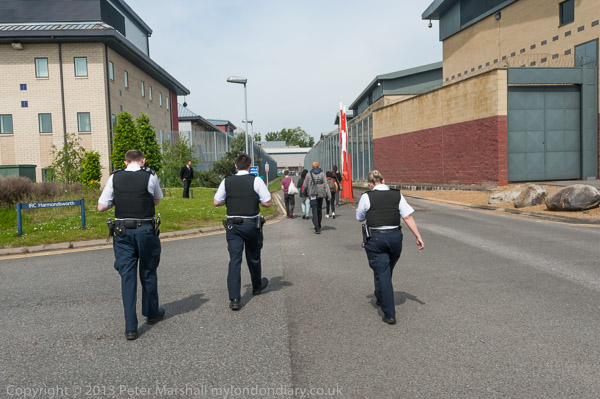
When the protest actually started, there were no problems with taking pictures, and the police had come to ask the protesters what they intended to do. The officer failed to get much of an answer, as nobody was in charge, but he told them that so long as they behaved sensibly the police would give them no problems.
Three police officers followed the protesters onto the road through the centre of the site – with Harmondsworth Detention Centre on the left and Colnbrook on the right. It is a private road, though the barrier on it was raised and we walked past it. It leads at the end to a site belonging to BT, and the whole area was until 1966 the home of the Road Research Laboratory which I visited while in the sixth form.
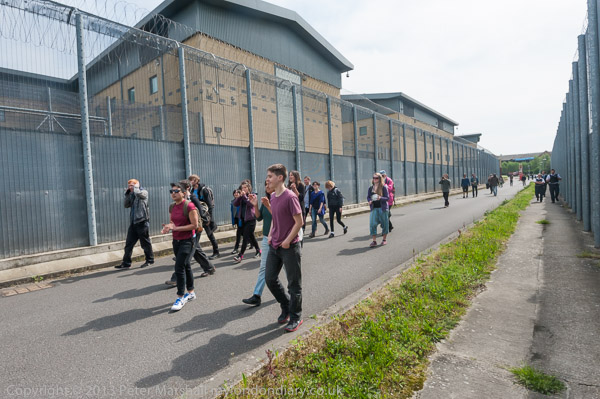
The officers – and the two men in Serco jackets who joined them – kept their distance and watched the protesters, but didn’t interfere with the protest, even when there was a complaint that it was disturbing the airport security dogs in their kennels just to the north of the prison. Last time I photographed a protest here, in November 2012, when the protesters kept drumming on the tall prison fence they were told that they would be arrested if they continued, and then issued a warning that they were committing an aggravated trespass and would be arrested if they returned to the site within 3 months, but today the police just stood and watched.
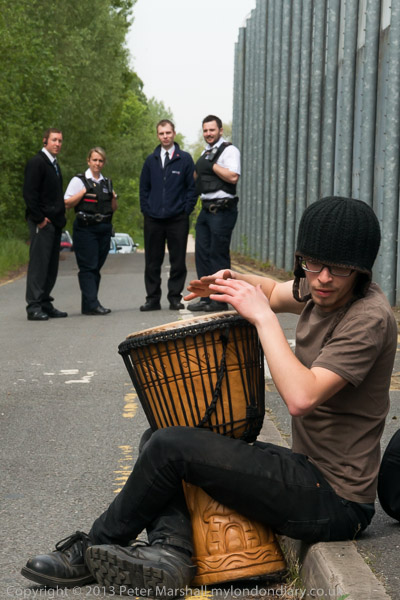
Most of the drumming today came from a drum, and I didn’t see anyone kicking the fence, though it was attacked rather firmly by a frying pan, though even more effective was thumping it with palms, which made the whole structure resonate.
Those inside the prison responded to the protest, waving out of the windows. Phone calls to and from some of those inside told the protesters how pleased the inmates were to know that some people at least in the UK cared what was happening to them.
Few of the windows are visible except through a tall – roughly 12 ft – fence, with fairly narrow gaps between the parallel wires that run along it. Auto-focus has no problems with focussing on the wire, but it is almost impossible to get it to auto-focus on the windows some distance behind. I was using the 70-300mm at or close to the longer end on either the D700 or the D800E, and the images are cropped down, and depth of field was minimal.
Auto-focus is great, but one of the small problems with cameras that rely on it is that manual focus becomes rather more tricky. Focussing screens just aren’t made to work as well as they did when we relied on manual focus. But manual was the only way to get the hands at the window anything like sharp. I don’t think they clean the windows, and inside them I think there is also a rather dirty and sometimes scratched plastic pane. So people and hands were hard to see. But they certainly wanted to be seen.
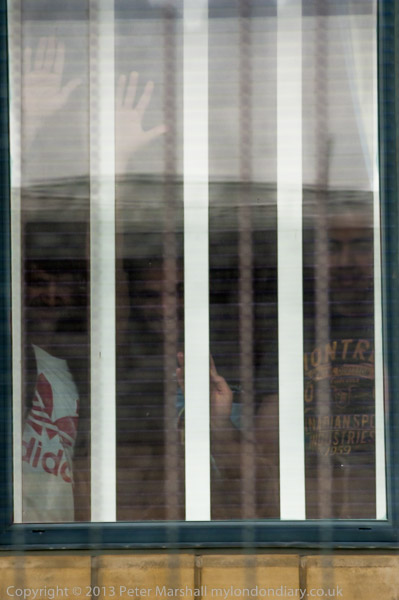
I couldn’t really tell on the camera read screen if there was anything sharp on these frames. The raw files opened in Lightroom gave flat and rather indistinct images, and there were problems too with colour balance, as well as with the whole image being seen between those well out of focus wires. Considerable post-processing was needed to get anything as distinct as you see here, and the horizontal wires and thicker vertical supports are still clearly visible over most of the image. What is rather surprising is the clarity of the designs on the shirts of two of the three men in the picture, although their hands and faces are still impressionistic.
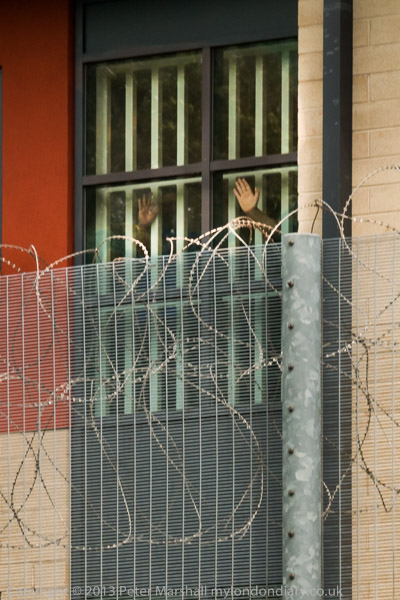
On the west side of the prison, the car park stretches some way back, to a low bank covered with trees. Standing a little up this gave a clear view over the top of the fence of the top of the top floor windows. Reflections of the sky in the glass still made the view far from clear, and quite a bit of post-processing, using the adjustment brush with various settings on different areas was needed.
You probably aren’t allowed to photograph here, but I’m sure there is an overriding public interest in making what is happening at places like this known.
______________________________________________________
My London Diary : Buildings of London : River Lea/Lee Valley : London’s Industrial Heritage
All photographs on this and my other sites, unless otherwise stated, are taken by and copyright of Peter Marshall, and are available for reproduction or can be bought as prints.
To order prints or reproduce images
________________________________________________________